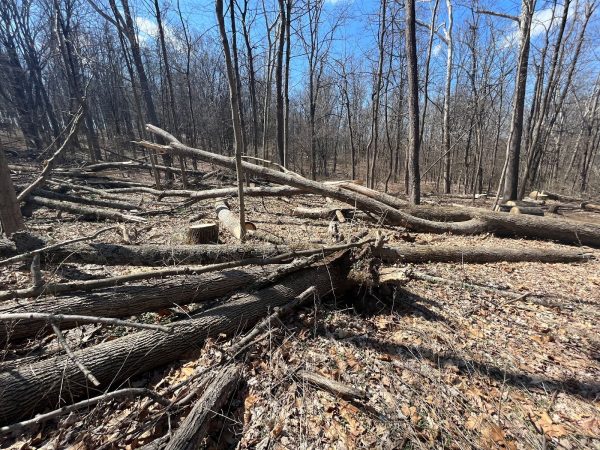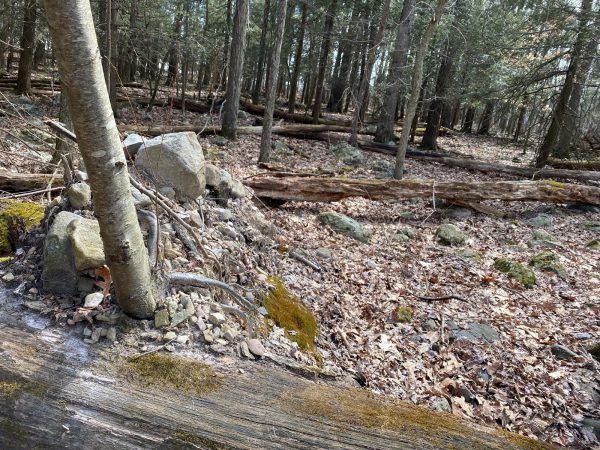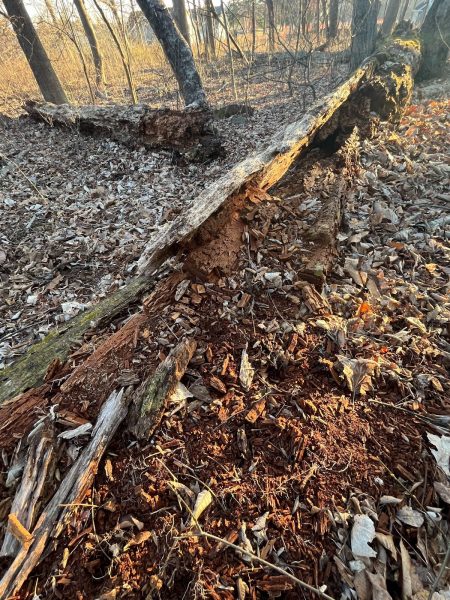Chicken of the woods fungi living on a dead log on Heritage Conservancy preserved land (Photo by Sebastian Harris).
All trees have a life expectancy. In Pennsylvania, some trees (like fire cherries) only live for a few decades, while other trees (such as oaks) can live for many centuries if no diseases cut their lives short. Trees provide countless benefits to the ecosystem as they grow, flower, and fruit. However, the benefits do not stop when the tree reaches the end of its life. There are many benefits a tree provides to the ecosystem long after its life concludes.
Wildlife Habitat
After a tree dies, it usually does not fall immediately. Dead-standing trees, also known as snags, are excellent wildlife habitats for many species. Multiple bird species forage under the bark or nest within the holes and cavities. Bats often use large hollow trees for roosting and raising their young, while other mammals may take shelter in larger cavities.

Once a tree falls, it creates different types of wildlife habitats. Downed trees and logs are ideal for salamanders, small mammals, invertebrates, and some important pollinator species. This habitat can also act as foraging or nesting sites for birds, and den sites for mammals. Many species of insects, fungi, and other microorganisms live and feed within the tree; recycling the energy back into the ecosystem.
Regeneration
A healthy forest will have trees in every stage of life. As older trees die, they leave gaps in the forest canopy. These gaps allow the growing saplings to eventually take the place of the dead tree in the canopy. Therefore, successful regeneration is vital to maintain forest diversity and health.

Decomposing trees on the ground help regeneration by creating what are known as nurse logs. Nurse logs create ideal conditions for small seeded trees. These logs stay moist and the decomposing wood provides excellent nutrient-rich substrate for the seedling to grow. Many trees, such as the black birch, benefit greatly from nurse logs to regenerate in an oak-dominated forest. Without large wood debris on the ground, forests will likely struggle to recruit some tree species, eventually reducing the diversity and overall health of the forest.
Soil
As a tree decomposes, it feeds a diversity of insects, fungi, and microorganisms. Those organisms break down the tree into an organic nutrient-rich soil that benefits the plants around it. This soil also holds moisture, further benefiting the plants and wildlife in the ecosystem. By letting the trees decompose on the forest floor, the ecosystem is able to recycle the nutrients and the forest will continue to thrive. If the trees and logs are extracted from the forest, the nutrients will not be recycled, which takes a long time to restore within an ecosystem.

While surveying forest health, the amount of wood on the forest floor is recorded as a positive feature. It provides food and shelter to wildlife, nutrient-rich soil, and a great place for the next generation of trees to begin their lives. Therefore, a healthy forest will have trees of all ages with large woody debris on the forest floor to ensure the forest continues in perpetuity. So next time you see a dead tree on the forest floor, try not to think about the loss of one life but rather the benefits it is providing to so many other lives and the forest as a whole.
Thanks for reading!
Tyler Kovacs, Conservation Steward.
